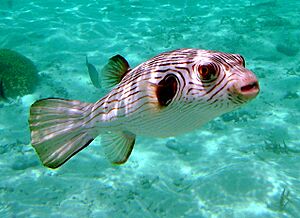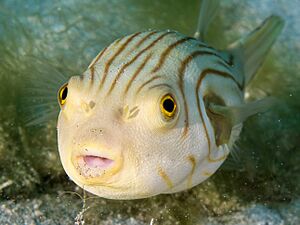Narrow-lined puffer facts for kids
Quick facts for kids Narrow-lined puffer |
|
|---|---|
 |
|
| Conservation status | |
| Scientific classification |
The narrow-lined pufferfish, also known as the striped puffer (scientific name: Arothron manilensis), is a fascinating marine fish. It lives near the bottom of the ocean, which means it's a demersal fish. This unique creature belongs to the family called Tetraodontidae, which are famous for their ability to puff up!
Contents
What Does the Narrow-Lined Pufferfish Look Like?
The narrow-lined pufferfish is a small fish, usually growing up to about 31 centimeters (or 12 inches) long. Its body is shaped like an oval, a bit round and stretched out. Unlike many fish, it doesn't have scales on its skin.
This pufferfish has some special features. It doesn't have pelvic fins (the ones usually found on the belly), and it also lacks a lateral line (a sensory organ that helps fish detect movement in water). Its dorsal fin (on its back) and anal fin (on its underside) are small and look the same, placed near its tail. It has a short snout with two sets of nostrils and a mouth at the very front with four strong teeth.
The pufferfish's body is usually whitish or gray with cool brown stripes running across it. All its fins are yellowish and a bit see-through, except for its caudal fin (tail fin). The tail fin is solid and has a black outline. You might also spot a black, roundish mark near its pectoral fin (the fin behind its gills). Even its eyes have a yellowish color!
Where Does the Striped Pufferfish Live?
You can find the narrow-lined pufferfish in the warm, tropical waters of the central Indo-Pacific region. It loves to live in places like estuaries, which are where rivers meet the sea. It also hangs out on sheltered coral reefs or in calm lagoons.
These fish usually stay in shallow waters, from the surface down to about 20 meters (65 feet) deep. They are often seen in areas with lots of seagrass or sandy bottoms. When they are young, these pufferfish often grow up among mangrove trees, which provide a safe nursery.
What Do Narrow-Lined Pufferfish Eat?
The narrow-lined pufferfish enjoys eating benthic invertebrates. This means it hunts for small creatures that live on or in the seafloor, like little crabs, snails, and worms.
How Does This Pufferfish Behave?
This pufferfish is active during the day, which means it has a diurnal activity pattern. It's also a bit of a loner, preferring to swim around by itself rather than in big groups.
Caring for a Narrow-Lined Pufferfish in an Aquarium
Many people enjoy keeping narrow-lined pufferfish in home aquariums. If you're thinking about it, here are some things to know:
- Water Type: They need saltwater.
- Water pH: The water should have a pH level between 7.6 and 8.2.
- Temperature: Keep the water temperature between 23-26 °C (74-80 °F).
- Size: They can grow up to 31 cm (12 inches) long.
- Tank Size: A large tank of at least 100 US gallons is recommended.
- Activity: They are active hunters, always looking for food.
- Lifespan: They can live for about 10 years.
- Breeding: It's unknown how they breed in aquariums.
- Gender: It's hard to tell males and females apart just by looking at them.
These pufferfish are quite sensitive to bad water conditions, especially high levels of nitrites and ammonia. It's super important to only put them in an aquarium that has been properly "cycled," meaning the water is stable and safe. To keep the water clean and healthy, adding a sump or refugium (extra water filtration systems) to the tank is a good idea.
What to Feed Them: They love to eat live and frozen foods. Good options include snails, freeze-dried krill, frozen shrimp, bloodworms (live or frozen), crab legs, and small crabs.
The narrow-lined puffer is a beautiful saltwater fish. They do well in tanks with live rock, as they enjoy exploring and searching the rock for tiny living things to snack on. They are generally peaceful with other fish. However, they are not reef safe. This means they will happily eat many of the invertebrates (like corals and snails) found in a reef aquarium. They also tend to be territorial, so it's best to keep only one narrow-lined pufferfish in a tank, as they might not get along with others of their own kind.



